Supplemental Materials for Journal Articles: NISO/NFAIS Joint Working Group
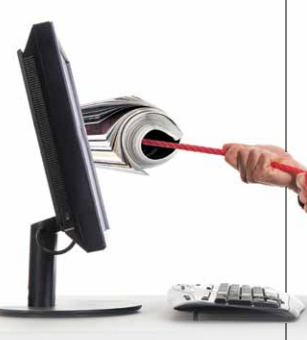
NOTE TO READER: Download the PDF to read the full article...
The tug of war between authors who wish to show all their work and editors concerned both about reader acceptance and page limits is an old story. Once electronic publishing was firmly established, both parties began to realize that supplemental materials could perhaps satisfy their concerns. The result, depending on the discipline and journal policy, was an initial trickle that grew rapidly into a flood for some. As with many aspects of electronic publishing, there were no standards or recommended practices for dealing with supplemental materials.
What emerged was a messy stew of different approaches
In fact, there exists no clear consensus on what constitutes supplemental materials. Some journal editors practice peer review, others do not. Some journals post supplemental materials along side the article within the journal; others post the materials to the open web. Often the latter are missing journal article connections. That is, the reader of the article will find a link to the supplemental materials, but the individual finding the materials serendipitously may not learn what they might have been attached to or what the context is for the data found in a table or figure. Journals rarely offer a recommended citation for the materials; indeed some journals warned initially that supplemental materials were never to be cited separately from the journal article. Most frequently, supplemental materials suffer from a lack of descriptive metadata.
Solving this messy problem is the purpose of one of NISO’s newest working groups. The goal of the Joint NISO/ NFAIS Working Group is to “create a Recommended Practice for publisher inclusion, handling, display, and preservation of supplemental journal article materials.” The impetus for the formation of this working group started two years ago.
Prelude I—NFAIS Working Group
In 2008, an NFAIS Working Group looked at the practices of publishing electronic journal articles overall. Initially directed toward best practices for article-by-article publishing, the group, representing primary and secondary publishers as well as librarians, in the end considered practices for all journal articles published in electronic form. Among the problems they focused on were workflow issues, confusion among versions, problems with citation structures, linking problems, and discoverability issues when articles did not reach Abstracting and Indexing (A&I) services promptly.
Best Practices for Publishing Journal Articles received final approval from the NFAIS Board of Directors in February 2009. That document included recommendations on 1) affirmation of the journal; 2) article retrieval; 3) version management; 4) supplemental materials; 5) content creator; 6) indication of length; 7) article identifiers; 8) citation elements required and publisher display of recommended citation; 9) tables of contents and indicators of completeness; 10) journal editor identification; and 11) copyright statement
One key recommendation on Supplemental Materials was that the journal make a clear connection between an article and the supplemental materials that accompany it. Once published, the supplemental materials should be considered part of the journal’s archival record and should not be changed without a clear statement of correction. Publishers, the document noted, should always supply a recommended citation as well as good, descriptive metadata for those materials. A&I services covering the journal article should include the presence of supplemental data in the article record, indicating file types and DOI.
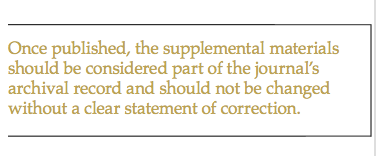
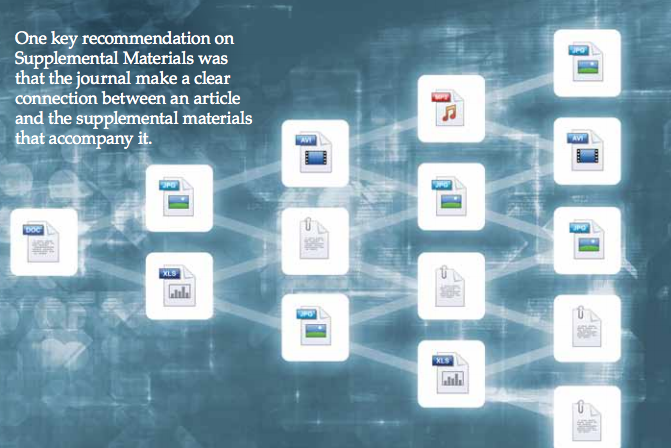
Prelude II—Schwarzman White Paper
n Fall 2009, Sasha Schwarzman, Information Analyst-Designer at the American Geophysical Union, surveyed a number of his technical colleagues in other organizations about their experience with supplemental or supporting materials. Based on the thoughtful responses he received from seven publishers, he wrote a white paper describing the lack of consensus around handling these materials.
Some variances stemmed from differences between print and electronic. If the print is considered the version of record, supplemental materials are likely to be items that cannot be printed because of their medium or format or due to page limits. If the electronic is the version of record, the distinction seems to be less clear and varies from publisher to publisher. Some journals restrict the number of components in supplemental materials. For example, Cell limits them to no more than twice the number of figures and tables in the article. Some designate as supplemental only those items that cannot be delivered in print.
Schwarzman found that there was no consensus on whether the materials should be included as an appendix to the article or placed online separately. Then, he noted, there are issues around readability, usability, preservation, and reuse. With rare exceptions, he found that publishers are not copy editing this content, treating it with the same deference they do article content, or marking it up. These deficits suggest that the odds of the content being as versatile and useful as the article itself or even having a very long life are slim. However, he noted that correcting these problems would result in substantial financial costs that would need to be borne by the publisher or the author. [See article on page 23 for more findings from this survey.]
Expanding the Discussion

Because of the growing interest in the topic and the amount of discussion that Schwarzman’s paper generated, Todd Carpenter, NISO’s Managing Director, suggested that NISO and NFAIS jointly sponsor a roundtable to discuss the issues that had been raised. When the group convened in Washington, D.C. in January 2010, nearly 70 people were engaged, either on site or on the phone for a meeting that lasted several hours.
Three speakers were invited to set the stage for discussion. First, Sasha Schwarzman expanded on his white paper to question where supplemental materials belong structurally within scientific articles. He noted it is essential to maintain these articles as a literary genre. Supplemental materials, he said, pose a threat of abuse: abuse of reviewers who are asked to review a catchall array of content and abuse of readers who may wade through an unreadable jumble of content. He discussed the costs and benefits and concluded with concerns about business models and uniform application of policies across the industry or even within a single journal.
Eefke Smit, Director of Standards and Technology, International Association of Scientific, Medical, and Technical Publishers (STM), presented a report on PARSE (Permanent Access to Records of Science in Europe). PARSE is a European Union project that aims to highlight the vulnerability of digital content. For the past two years, the project has been creating an inventory with surveys and case studies. Their findings are that datasets and supplemental materials are the least organized for preservation. The characteristics of an ideal system, they note, include a good linking system, reliable metadata, certification of repositories, and registration of datasets.
Scott Dineen, Deputy Senior Director of Publications, Optical Society of America (OSA), provided an update on the Interactive Science Publishing project OSA undertook in publishing large databases with its journals. The experiment, a partnership with the National Library of Medicine, included a DSpace architecture (MIDAS) that would allow them to accept datasets. They then created viewing software to allow readers to rotate, crop, zoom, and analyze. Thus, a reader could, for example, view 3D lung cancer datasets in context. One of the key issues was a lack of metadata. OSA is now looking at funding and business models to continue the work.
Defining the Problem
The first question for discussion was what exactly are supplemental materials. Although the group rather quickly developed a potential list of content types (see sidebar), the deeper question of what is designated as supplemental went unanswered. Different organizations approach the materials differently. For example, AGU’s position is that these materials provide the next step for the reader who wishes more information, but should not be essential to the reader’s understanding of the article. On the other hand, AAAS, the publisher of Science, treats supplemental materials as a tool for authors to make their case, thereby making supplemental materials “essential to the scientific integrity of the article.” Articles published in Science are frequently very short, whereas the supplemental materials may be quite extensive.
Decisions about what is supplemental have thus far been largely subjective and may be made independently by any of several players. The group discussed potential roles for authors, peer reviewers, editors, publishers, and libraries/data centers. All agree that supplemental materials should receive the same level of peer review that an article does; however, there are real questions about how that is done today and how publishers might cover the costs of the review.
Findability, participants agreed, is a big issue in part because A&I services receive inconsistent notification. Some publishers supply good metadata and others do not. Some assign DOIs and others do not. Among the significant questions the Roundtable posed are these:
» What exactly are supplemental materials? Should they be considered part of the main article or might they be linked, but separate items?
» What is the impact for preservation, citations, and copyright agreements?
» Some materials from extensive studies may be shared across articles and perhaps across authors. How will this work?
» How can costs be managed?
» How might issues around sharing data be handled? Among these issues are sensitive information, such as patient data; permission or use restrictions; embargoes; and the growing requirement to share data.
» How will publishers weigh competing user needs around supplemental materials?
Moving Forward
In discussing the formation of a follow-up working group, participants in the Roundtable identified some general issues for potential Recommended Practices. Among them are the following:
» Clear, consistent indicators of content
» Metadata needs
» Universal agreement on citation practices
» Consideration of use of the DOI
» Potential cost recovery
» Common vocabulary
» Peer review
» Preservation and interaction with repositories
» Archiving
» Clearly defined specific responsibilities for the parties involved in scholarly publication.
Further discussion can be found in the report of the Roundtable Meeting
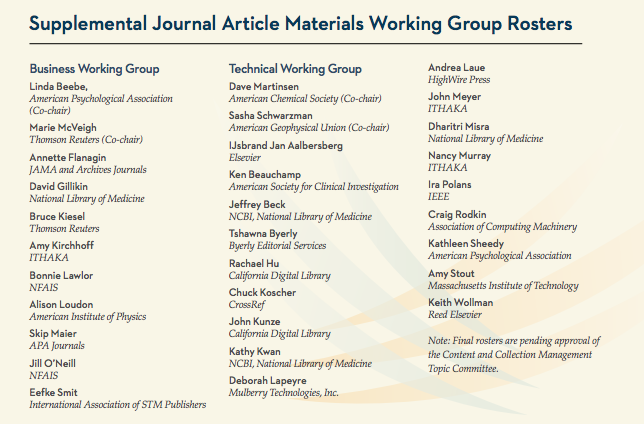
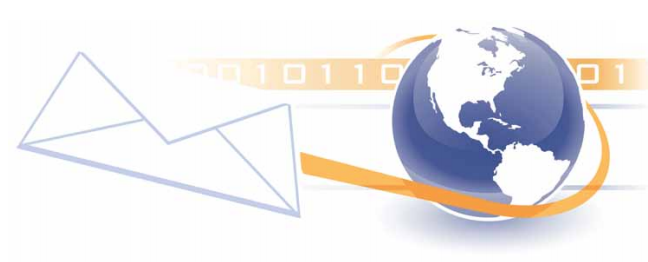
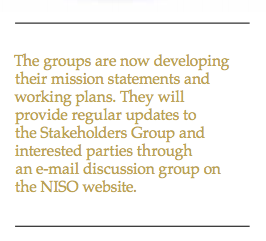
Participants agreed that it would be important to move forward with a defined proposal to create Recommended Practices for Supplemental Materials under the NISO Recommended Practice publication series. Given the scope of the problem, they agreed that the Working Group should be composed in three parts:
- Stakeholders Interest Group − a larger group to be kept apprised of development, to serve as a source of feedback on drafts, and to provide community vetting of a final document.
- Business Working Group − a small group to draft recommendations related to the semantic aspects of the Recommended Practices. These include what constitutes supplemental materials, definitions, recommended roles, business practices, and policy questions.
- Technical Working Group − a small group to look at the syntactic, structural issues, such as syntax, linking, interoperability, markup, and metadata.
Current Status
The NISO Content & Collection Management Topic Committee approved the proposal in late Spring 2010. The two small working groups have been formed with Linda Beebe from American Psychological Association and Marie McVeigh from Thomson-Reuters co-chairing the Business Working Group and David Martinsen from American Chemical Society and Sasha Schwarzman from American Geophysical Union co-chairing the Technical Working Group. The groups both include representatives from a broad spectrum across the scholarly information community.
The groups are now developing their mission statements and working plans. They will provide regular updates to the Stakeholders Group and interested parties through an e-mail discussion group on the NISO website. Interested parties can join the list by sending an e-mail to: suppinfo-subscribe@list.niso.org. Because the issues are thorny, it is likely to be sometime later in 2011 before Recommended Practices are finalized for acceptance.
Publication data
DOI10.3789/isqv22n3.2010.07
/sites/default/files/stories/2019-09/Beebe_SuppMatls_WG_ISQ_v22no3%20%281%29.pdfVolume 22, Issue 3 (Summer 2010)